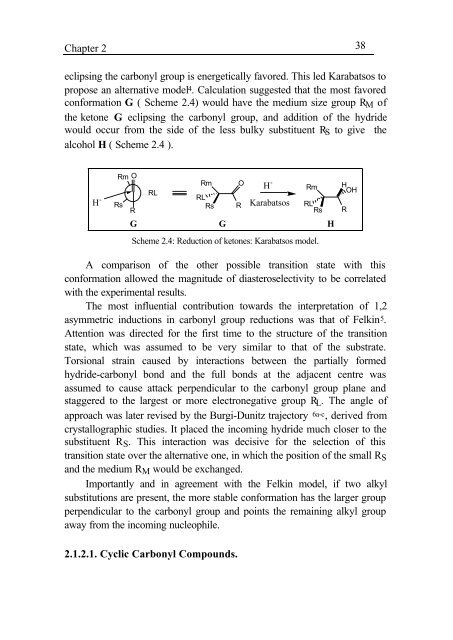Advances in the stereoselective synthesis of antifungal agents and ...
Advances in the stereoselective synthesis of antifungal agents and ...
Advances in the stereoselective synthesis of antifungal agents and ...
You also want an ePaper? Increase the reach of your titles
YUMPU automatically turns print PDFs into web optimized ePapers that Google loves.
Chapter 2 38eclips<strong>in</strong>g <strong>the</strong> carbonyl group is energetically favored. This led Karabatsos topropose an alternative model 4 . Calculation suggested that <strong>the</strong> most favoredconformation G ( Scheme 2.4) would have <strong>the</strong> medium size group R M <strong>of</strong><strong>the</strong> ketone G eclips<strong>in</strong>g <strong>the</strong> carbonyl group, <strong>and</strong> addition <strong>of</strong> <strong>the</strong> hydridewould occur from <strong>the</strong> side <strong>of</strong> <strong>the</strong> less bulky substituent R S to give <strong>the</strong>alcohol H ( Scheme 2.4 ).Rm ORm O H - RmRLRLH - Rs Rs R Karabatsos RLR RsG G HHOHRScheme 2.4: Reduction <strong>of</strong> ketones: Karabatsos model.A comparison <strong>of</strong> <strong>the</strong> o<strong>the</strong>r possible transition state with thisconformation allowed <strong>the</strong> magnitude <strong>of</strong> diasteroselectivity to be correlatedwith <strong>the</strong> experimental results.The most <strong>in</strong>fluential contribution towards <strong>the</strong> <strong>in</strong>terpretation <strong>of</strong> 1,2asymmetric <strong>in</strong>ductions <strong>in</strong> carbonyl group reductions was that <strong>of</strong> Felk<strong>in</strong> 5 .Attention was directed for <strong>the</strong> first time to <strong>the</strong> structure <strong>of</strong> <strong>the</strong> transitionstate, which was assumed to be very similar to that <strong>of</strong> <strong>the</strong> substrate.Torsional stra<strong>in</strong> caused by <strong>in</strong>teractions between <strong>the</strong> partially formedhydride-carbonyl bond <strong>and</strong> <strong>the</strong> full bonds at <strong>the</strong> adjacent centre wasassumed to cause attack perpendicular to <strong>the</strong> carbonyl group plane <strong>and</strong>staggered to <strong>the</strong> largest or more electronegative group R L . The angle <strong>of</strong>approach was later revised by <strong>the</strong> Burgi-Dunitz trajectory 6a-c , derived fromcrystallographic studies. It placed <strong>the</strong> <strong>in</strong>com<strong>in</strong>g hydride much closer to <strong>the</strong>substituent R S . This <strong>in</strong>teraction was decisive for <strong>the</strong> selection <strong>of</strong> thistransition state over <strong>the</strong> alternative one, <strong>in</strong> which <strong>the</strong> position <strong>of</strong> <strong>the</strong> small R S<strong>and</strong> <strong>the</strong> medium R M would be exchanged.Importantly <strong>and</strong> <strong>in</strong> agreement with <strong>the</strong> Felk<strong>in</strong> model, if two alkylsubstitutions are present, <strong>the</strong> more stable conformation has <strong>the</strong> larger groupperpendicular to <strong>the</strong> carbonyl group <strong>and</strong> po<strong>in</strong>ts <strong>the</strong> rema<strong>in</strong><strong>in</strong>g alkyl groupaway from <strong>the</strong> <strong>in</strong>com<strong>in</strong>g nucleophile.2.1.2.1. Cyclic Carbonyl Compounds.















